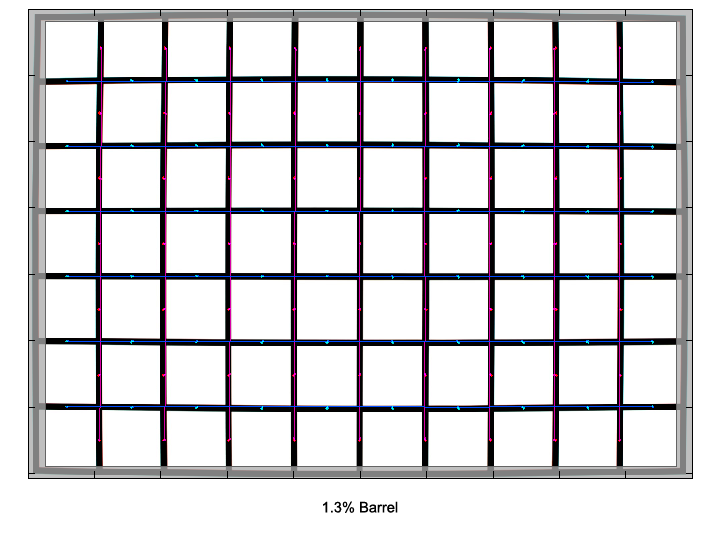|
Page 2 of 2

Distortion
The lens shows a moderate amount of barrel distortion. This can be visible in critical shots especially with straight lines near the image borders. However, the distortion is uniform and easy to correct in post processing.

The chart above has a real-world size of about 120x80cm.
Vignetting
Typical for many fast FX lenses, the Sigma shows slightly pronounced vignetting wide open, which is reduced to practically irrelevant levels by stopping down.

MTF (resolution)
The lens shows very good resolution in the image center wide open, which increases to excellent levels by stopping down to f/4.
The borders and corners are a very different story, though. The borders are just fair wide open, but already recover to good resolution when stopped down to f/2.8. The extreme corners are even across the whole tested aperture range. They are poor wide open and recover to only fair values by stopping down.
Please note that the MTF results are not directly comparable across the different systems!
Below is a simplified summary of the formal findings. The chart shows line widths per picture height (LW/PH) which can be taken as a measure for sharpness.
If you want to know more about the MTF50 figures you may check out the corresponding Imatest Explanations

Chromatic Aberrations (CAs)
Chromatic aberrations (color shadows at harsh contrast transitions) are moderate wide open, but a bit pronounced throughout the rest of the aperture range.
However, CAs can easily be corrected in software or by the camera itself (most modern Nikon DSLRs remove CAs themselves if you shoot JPGs).

Bokeh
One of the primary usage scenarios for a large aperture lens is to separate the main subject from the background. In such an image the quality of the bokeh (out-of-focus blur) is of major significance.
At large apertures, the EX 24 shows quite smooth bokeh in front of the focal plane, but some signs of nervousness behind it, especially in the transition zone.
Background highlights also look quite nervous and in addition show pronounced outlining. Towards the image borders, they are cut off at large aperture due to mechanical vignetting.
Both the general bokeh quality as well as background highlights improve in quality by stopping down. However, with a wide angle lens one needs to get quite close to the main subject to still get a significant amount of background blur. The lens' very short minimum focus distance comes handy here.

Bokeh Fringing
Bokeh fringing (non-coinciding focal planes of the various colors) is a common issue with relatively fast glass. As you can
notice below, the halos have different colors - magenta (red + blue) in front the focus point
and green beyond. Truly "apochromatic" lenses don't show this kind of fringing but these lenses are very rare - especially
below 100mm. Unlike lateral CAs, bokeh fringing cannot easily be fixed in post processing.
Typical for most fast primes, the EX 24 shows some amount of fringing at large aperture settings, which can of course be reduced by stopping down.
Sample Images
You can find some sample images taken with the Nikon D3x in our Nikon FX review of the lens.
VerdictJust like its slightly longer sister lens, the Sigma AF 24mm f/1.8 EX DG leaves us with a mixed feelings. The center resolution of the lens is nothing to complain about, at least when stopped down, while the borders and especially corners disappoint.
Vignetting is a bit pronounced wide open, but no issue stopped down. Distortion and CAs are moderate.
The bokeh is somewhat nervous at large apertures, but improves considerably when stopped down a little.
The build quality is a bit of a negative surprise because of the wobbling inner lens tube. Since the lens has no internal motor, it doesn't autofocus on Nikon's entry-level DX cameras.
So, just like the EX 28/1.8, it's not an overly attractive choice for DX shooters, but because of its very short minimum focus distance it's an interesting lens to shoot close-ups with wide perspectives.
| Optical Quality: |
 to to  |
|
| Field Quality: |  (press and street photography) (press and street photography) |
|  (Close-up fun) (Close-up fun) |
| Mechanical Quality: |  (downrated due to wobbling) (downrated due to wobbling) |
| Price/Performance: |  |
| | |
| | What does this mean ? |
|